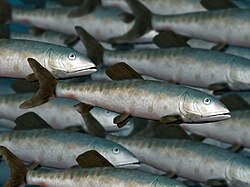Top Qs
Timeline
Chat
Perspective
Calcare di Sogno
Geological formation in Italy From Wikipedia, the free encyclopedia
Remove ads
The Calcare di Sogno ("Sogno Limestone"; also known as the Sogno Formation) is a geological formation in Italy, dated to roughly between 182 and 169 million years ago and covering the Lower Toarcian-Late Bajocian stagess of the Jurassic Period in the Mesozoic Era.[1] Thalattosuchian remains are known from the formation, as well as fish and other taxa.[2]
Remove ads
Description
During the Early Jurassic, concretely towards the Toarcian, the Lombardy Basin became a relatively deep, fully pelagic area, located between the so-called Lugano High, at the west, and the Trento Plateau to the east, with several troughs and palaeohighs (West to east: Monte Nudo Trough, Lugano High, Generoso Trough, Corni di Canzo High, Albenza Plateau, Monte Cavallo High, Sebino Trough and Botticino High).[3] The formation is characterized by a disposition of regional deposition equivalent to the German Posidonia Shale, with a benthic setting and deposition trends, mostly populated by marine fauna.[4] The environment of the formation was related to a marginal marine deposit, with probably epicontinental deposition from near land environments, being connected to the central European seas and the North African currents of the Toarcian.[5] The formation is linked with the Toarcian Anoxic Event, that is measured in the “Fish Level”, that is also the most fossiliferous section.[6]
Remove ads
Environment
Summarize
Perspective
Two cores, the Colle di Sogno and Gajum are among the best sections that recovered the ecological changes in the Pliensbachian-Toarcian Lombardy Basin.[7] Carbon-and oxygen-isotope data calibrated against nannofossil biostratigraphy has shown that the palaeobathymetry of the deposits was about 1000 and 1500 m, being the deepest records of the T-OAE in the western Tethyan region.[8] As the Sogno Formation was deposited mostly in a pelagic setting, influenced by both the European and African bioregions, taxa of several provenances mix in this layer. The Nannofosil assemblage, that ranges from moderate/poor to good decreasing in the Toarcian AOE (drastic decrease in total abundance is observed in the Fish Level), includes the taxa Lotharingius (L. hauffii, L. sigillatus, L. crucicentralis, L. velatus), Discorhabdus ignotus, Diductius constans, Carinolithus (C. poulnabronei, C. superbus), Mitrolithus jansae and Watznaueria sp.1 in the Gajum Core, while the Sogno Core shows abundance of the genera Biscutum, Calyculus, Carinolithus and Crepidolithus, whereas Bussonius, Diductius, Similiscutum, Parhabdolithus and Tubirhabdus are extremely rare.[9] The overall structure of this microtaxa assemblage trends to suggest a correlation with the biohorizon seen in coeval layers in the Lusitanian Basin, where a common trend is observed in the Western Tethys of north–south migration pathway for several organisms, including calcareous nannoplankton and ammonites.[9]
A local index genus for environment evolution is Schizosphaerella spp. (specially S. punctulata), showing a lower valve size than in coeval layers on connected basins (Lusitanian and Paris Basins), as local result of the Lower Toarcian Jenkyns Event, indicating changes in ocean acidification and fertility rather than temperature.[10]
Remove ads
Fossil content
Summarize
Perspective
Ichnofossils
Molluscs
Arthropods
Fish
Crocodyliformes
Flora
Several plant leaves and fragments of wood were not identified.[18]
Remove ads
See also
- List of fossiliferous stratigraphic units in Italy
- Toarcian turnover
- Toarcian formations
- Marne di Monte Serrone, Italy
- Podpeč Limestone, Slovenia
- El Pedregal Formation, Spain
- Mizur Formation, North Caucasus
- Sachrang Formation, Austria
- Posidonia Shale, Lagerstätte in Germany
- Irlbach Sandstone, Germany
- Ciechocinek Formation, Germany and Poland
- Krempachy Marl Formation, Poland and Slovakia
- Djupadal Formation, Central Skane
- Lava Formation, Lithuania
- Azilal Group, North Africa
- Whitby Mudstone, England
- Fernie Formation, Alberta and British Columbia
- Whiteaves Formation, British Columbia
- Navajo Sandstone, Utah
- Los Molles Formation, Argentina
- Mawson Formation, Antarctica
- Kandreho Formation, Madagascar
- Kota Formation, India
- Cattamarra Coal Measures, Australia
Remove ads
Notes and references
Wikiwand - on
Seamless Wikipedia browsing. On steroids.
Remove ads


















